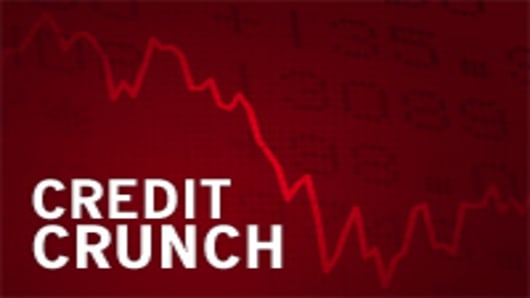The credit crisis, now over a year old, is showing no signs of letting up.
"What has been the most surprising is the length of this downturn. We are now well over a year into this problem and conditions are still weak,” said Brad Hintz, an analyst at Sanford Bernstein Research and a former CFO of Lehman Brothers.
Financial institutions world wide have so far taken $341 million in credit-related writedowns. Bear Stearns collapsed and was folded into former rival JPMorgan. Federal regulators seized IndyMac, one of the largest U.S. mortgage lenders, and two other smaller lenders. The government was forced to rescue home-financing giants Fannie Mae and Freddie Mac. And we’ve seen the ouster of two CEOs, two CFOs and a slew of other executives.
Since the end of July 2007, the Dow has dropped 13 percent, the euro has gained 14 percent against the dollar and oil has surged 60 percent. Oil stocks have risen to the top of the market pack and financials have fallen to the bottom. Among the top five decliners on the S&P 500 in the past year were MBIA, Washington Mutual and Freddie Mac, all of which have lost more than 85 percent.
"It was like watching a slow-motion train wreck of the financial markets,” Hintz said.
And it’s not over yet.
“I still think we have a long ways to go,” Greg Peters, head of credit research at Morgan Stanley, said on CNBC. “We still have the knock-on effect of lenders not lending.”
Visibility is a huge problem that has rattled the trust of lenders: Too many people have been burned by a declaration of “we’re fine,” only to find out a few days later that the firm isn’t within a 500-mile radius of fine.
Banks borrowed a record $17.45 billion a day from the Fed last week and the Fed announced it will extend its emergency lending offer through January to try to stem the bleeding.
Plus, market pros say there will probably be at least two more quarters of writedowns to come.
Not Even Halfway There
“I think we’re less than 50 percent of the way done,” Oppenheimer analyst Meredith Whitney said on CNBC. “The capital raised –- hundreds of billions of dollars -– has just plugged holes,” Whitney said. “They’re not growing capital.”
Whitney offered a startling projection: She says we’ll probably see 25-plus institutions come back for capital within the next two months.
(Click on the video at left to watch the interview with Meredith Whitney.)
When asked if she thought Lehman Brothers, which has been in the crosshairs of short sellers, can survive this crisis, Whitney replied, after much deliberation: “I don’t know.”
Analysts say we’re almost guaranteed to lose more banks before it’s all over -– maybe half a dozen, by some estimates.
Hintz said the Fed's actions -- brokering the JPMorgan buyout of Bear Stearns and opening the discount window -- were “successful” but cautioned that more needs to be done.
"No one likes to be regulated but we need tighter regulations," said Peter Cardillo, chief market economist at Avalon Partners. "The blame lies with the ex-chairman [Alan Greenspan] for having kept interest rates too low for too long – it created excessive speculation in the credit markets. Credit was very loose, very easy to get."
Part of the increase in leverage that has exacerbated the problems of brokers can be traced back to SEC rules set in 2004. Given the failure of Bear Stearns, he said, expect the SEC to "significantly modify these rules" and take action to boost the liquidity of brokers.
It all started with housing and, market pros say, it will end with housing.
“A lot still depends on whether we see some stabilization in the housing market, something I believe will happen by year end,” said David Twibell, president of wealth management at Colorado Capital Bank.
It will take three months of stable housing numbers to really declare the housing market is in recovery mode, analysts say, and to start rebuilding trust in the lending market.
The Fed and Treasury have taken a lot of heat in the past year for not acting quickly enough and for what some say is slapping a Band-Aid on a gaping wound.
“Some of it is deserved, but to be honest, they were dealt a pretty tough hand,” Twibell said. “Certainly they both could have been more proactive. But in the end, this mess had to unwind and there was going to be a certain level of pain no matter what they did,” he said.
What Have We Learned?
The dot-com bubble burst just eight years ago, wreaking havoc on the market. And yet, here we are again.
"The biggest thing we learned is that we will never learn!" Cardillo said. "Because some genius from Harvard – some Oxford genius – will come in with some new gimmick that will intrigue Wall Street and somewhere along the line, we'll have another bubble and another crisis."
(Remember Cramer's rant heard 'round the world? Click on the video at left.)
The days of simple investing are gone, Cardillo said. "Technology permits the finding of new instruments. And those new instruments generally wind up being a problem – they create excessive speculation," he said.
In the meantime, the housing market is trying to stabilize, the stock market is searching for the real bottom, and the economy is showing some small signs of hope.
“I think we may be on the path that leads to the path of recovery,” Twibell said. “I think we’ll look back in a year and point to this summer as the time when things started to turn around for the market.”




